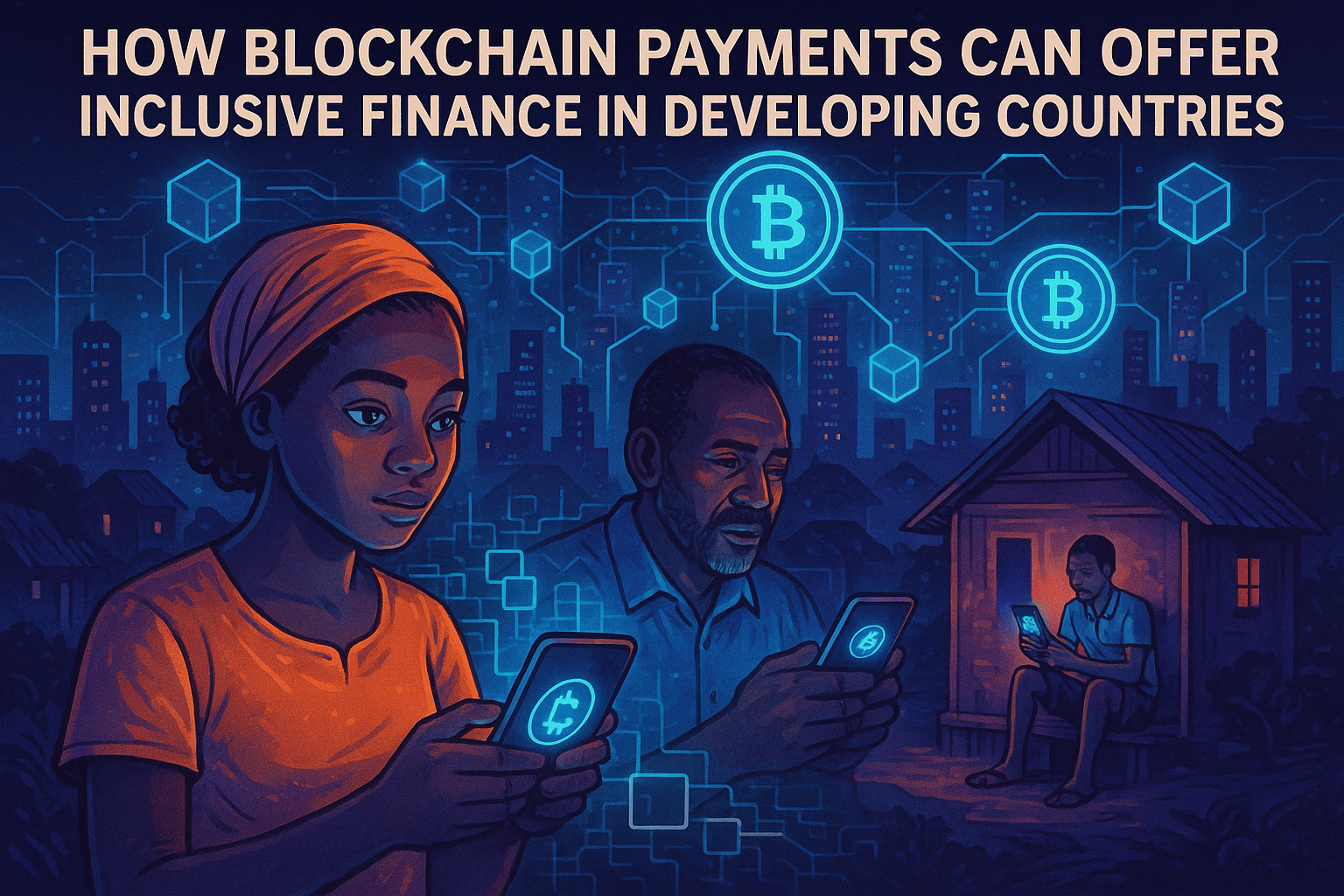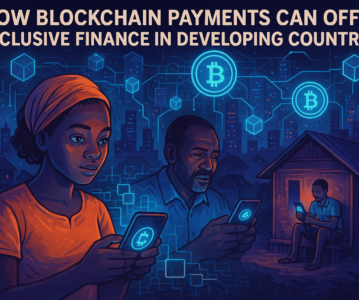Introduction
Financial inclusion is widely recognized as a catalyst for economic growth and poverty reduction, especially in developing countries where large segments of the population remain excluded from traditional financial services. The World Bank estimates that around 1.4 billion adults globally are unbanked, with the majority residing in low- and middle-income nations. This exclusion limits individuals’ ability to save securely, access credit, receive remittances, and participate in broader economic activity.
In recent years, fintech innovation has offered new models for bridging these gaps, with blockchain technology and digital payments emerging as potentially transformative solutions. Blockchain payments promise to address persistent issues such as high transaction costs, limited banking infrastructure, and lack of trust in financial intermediaries. This article provides a comprehensive exploration of how blockchain payments can drive inclusive finance in developing countries, analyzing current barriers, technological fundamentals, real-world applications, and future prospects.

Current State of Financial Inclusion in Developing Countries
Despite notable progress over the past decade, financial exclusion remains pervasive in many parts of the developing world. According to the 2021 Global Findex Database, while global account ownership increased from 51% in 2011 to 76% in 2021, the percentage is still significantly lower in regions such as Sub-Saharan Africa (55%) and the Middle East and North Africa (44%). Women, rural populations, smallholder farmers, and micro-entrepreneurs are disproportionately affected by this exclusion.
A multitude of barriers contribute to this scenario. First, physical access to bank branches or ATMs is often limited by poor infrastructure in remote and rural areas. Second, the costs of maintaining accounts and conducting transactions can be prohibitive for low-income individuals. Third, documentation requirements—such as proof of address or identification—exclude many, particularly refugees, migrants, and those working in the informal sector. Additionally, lack of trust in financial institutions and limited financial literacy further inhibit adoption.
Micro, small, and medium-sized enterprises (MSMEs), which are the backbone of developing economies, also struggle. The International Finance Corporation (IFC) estimates that 65 million firms, or 40% of formal MSMEs in developing countries, have an unmet financing need of $5.2 trillion every year. The gap is even wider for informal businesses, which often lack collateral and credit histories. These challenges underscore the urgent need for accessible, affordable, and reliable financial solutions tailored to underserved populations.
Blockchain Technology Overview
Blockchain is a decentralized digital ledger technology that records transactions across multiple computers in a secure, transparent, and immutable manner. Its core characteristics—distributed consensus, cryptographic security, transparency, and programmability—make it uniquely suited for transforming payment systems and expanding financial access.
At its essence, a blockchain consists of blocks of data linked together in chronological order, each secured by cryptographic hashing and validated by a network of participants (nodes). Unlike traditional centralized payment systems, blockchain operates without a single controlling authority. This decentralization reduces reliance on intermediaries, lowers the risk of fraud, and enables peer-to-peer transactions across borders.
Smart contracts, a key feature of programmable blockchains like Ethereum, allow for the automation of complex financial processes—such as loans, remittances, and insurance—based on predefined conditions. Moreover, permissionless blockchains enable anyone with an internet connection to participate, removing some of the traditional barriers to account ownership and transaction initiation.
Another advantage lies in the transparency and auditability of blockchain transactions. All records are publicly accessible and cannot be altered retroactively, fostering trust and accountability. This is particularly important in developing economies, where corruption and lack of transparency have historically undermined confidence in financial systems.
How Blockchain Payments Enable Financial Inclusion
Lowering Barriers and Reducing Costs
One of the most significant ways blockchain payments foster inclusion is by dramatically reducing transaction costs. Traditional international remittances, for example, incur average fees of around 6% according to the World Bank’s Remittance Prices Worldwide database. Blockchain-based solutions can reduce these costs to less than 1% by cutting out intermediaries and processing payments directly between sender and receiver. This is particularly impactful for migrant workers sending money home, as remittances often represent a vital lifeline for families in developing nations.
Account setup and maintenance are also streamlined. With blockchain, individuals can create digital wallets without the need for extensive documentation, credit history, or physical presence. All that is needed is access to a mobile phone and the internet—resources that are rapidly proliferating even in the world’s poorest regions. This opens the door for the unbanked to participate in digital finance, save securely, and receive payments instantly.
Increasing Accessibility and Transparency
Blockchain payments are accessible 24/7, unconstrained by bank operating hours or geographical limitations. This is crucial for people in rural or conflict-affected areas where banking infrastructure is sparse or unreliable. Mobile-based blockchain wallets, compatible with basic smartphones, are already making it possible for individuals to transact, save, and access digital services without relying on brick-and-mortar institutions.
Transparency is another key benefit. Every transaction on a public blockchain is visible and verifiable, reducing the risk of misappropriation or fraud. For governments and aid organizations, this means social welfare payments, subsidies, or humanitarian aid can be distributed with greater accountability, ensuring funds reach their intended recipients.
Fostering Trust and Financial Empowerment
In environments where trust in formal financial institutions is low, blockchain offers a neutral and tamper-proof alternative. The transparency and immutability of records can help build confidence among users, while the ability to control one’s own digital assets fosters a sense of financial empowerment. Additionally, blockchain’s programmability supports the development of tailored financial products—such as microloans or insurance—delivered efficiently and transparently to underserved populations.
Case Studies and Real-World Applications
Remittances: BitPesa (now AZA Finance) in Africa
BitPesa, now known as AZA Finance, is a Nairobi-based fintech company that leverages blockchain for cross-border payments in and out of Africa. By using Bitcoin as a bridge currency, BitPesa enables businesses and individuals to send and receive payments across multiple African countries and international markets at significantly lower costs and faster settlement times than traditional banking channels. For example, BitPesa’s average transaction fees are often less than half those of conventional money transfer operators. The platform has facilitated millions of dollars in transactions for SMEs, supporting trade and commerce across borders.
Humanitarian Aid: Building Blocks in Jordan
The World Food Programme’s (WFP) Building Blocks project is a pioneering example of blockchain for humanitarian assistance. Piloted in Jordan’s Azraq and Zaatari refugee camps, the project uses an Ethereum-based blockchain to distribute food and cash assistance to over 100,000 Syrian refugees. Beneficiaries receive entitlements directly into digital wallets linked to biometric authentication, allowing them to purchase food at participating stores. The system has improved transparency, reduced fraud, and cut operational costs by up to 98%, demonstrating blockchain’s potential for secure and efficient aid disbursement.
Financial Services: Celo and M-Pesa Integration
Celo is an open-source blockchain platform designed for mobile-first financial services. In Kenya, Celo has integrated with M-Pesa, the country’s dominant mobile money system, enabling seamless conversion between M-Pesa balances and Celo’s cUSD, a stablecoin pegged to the US dollar. This allows users to transact, save, or remit digital dollars easily, circumventing volatility risks associated with local currencies. The integration has expanded access to digital assets and cross-border payments for millions of Kenyans, particularly those underserved by banks.
Digital Identity and Microfinance: BanQu in Latin America
BanQu is a blockchain-based platform focused on providing economic identity to marginalized populations, such as smallholder farmers in Latin America. By recording transaction histories on a blockchain, BanQu allows farmers to build a verifiable credit profile, enhancing their access to microloans and fair market prices. For example, in Honduras, BanQu has partnered with beverage companies to track coffee supply chains and ensure transparent, direct payments to farmers. This has resulted in greater financial inclusion, improved livelihoods, and more efficient value chains.
Challenges and Limitations
Technical and Infrastructure Barriers
Despite its promise, blockchain adoption in developing countries faces significant technical hurdles. Reliable internet access and smartphone penetration, while improving, remain uneven. According to GSMA’s 2023 Mobile Economy report, only 55% of Sub-Saharan Africa’s population had mobile internet access as of 2022. Electricity shortages and high data costs can further limit usability, especially in rural areas.
Scalability and transaction throughput are additional concerns. Public blockchains like Ethereum have faced congestion and high transaction fees during periods of peak demand, undermining affordability for low-value transactions. While newer solutions such as layer-2 networks and more efficient consensus mechanisms are emerging, mainstream adoption will depend on continued technological refinement.
Regulatory and Policy Uncertainty
Regulatory uncertainty is another major challenge. Many developing countries lack clear legal frameworks for digital assets, leading to confusion and risk for users and service providers. Some governments, wary of capital flight, money laundering, or loss of monetary sovereignty, have imposed outright bans or severe restrictions on cryptocurrencies. This can stifle innovation and limit the reach of blockchain-based financial services.
At the same time, the pseudonymous nature of blockchain transactions raises concerns about compliance with Anti-Money Laundering (AML) and Know Your Customer (KYC) regulations. Balancing user privacy with regulatory oversight remains a complex issue for policymakers.
User Education and Trust
Low levels of digital and financial literacy present another barrier to adoption. Many potential users are unfamiliar with concepts such as digital wallets, private keys, or stablecoins. Without targeted education and user-friendly interfaces, the risk of user error or fraud increases. Additionally, concerns over the security of digital assets—highlighted by high-profile hacks and scams—can erode trust among first-time users.
Volatility and Currency Risk
The price volatility of cryptocurrencies like Bitcoin and Ethereum poses significant risks for low-income populations. While stablecoins and central bank digital currencies (CBDCs) offer more stable alternatives, their adoption is still in early stages. Ensuring reliable fiat on- and off-ramps is crucial to maintaining value and usability for everyday transactions.
Summary and Future Trends
Blockchain payments hold significant potential to advance inclusive finance in developing countries by lowering costs, increasing transparency, and expanding access for underserved populations. Case studies from Africa, the Middle East, and Latin America demonstrate real-world impact, from remittances and humanitarian aid to microfinance and digital identity.
However, challenges remain. Technical infrastructure, regulatory clarity, user education, and currency stability must be addressed to unlock the full benefits of blockchain-based financial services. Stakeholders—including governments, fintech firms, international organizations, and local communities—must collaborate to develop enabling environments, promote responsible innovation, and ensure that solutions are tailored to local contexts.
Looking ahead, several trends are likely to shape the future of blockchain-enabled inclusive finance:
- Stablecoins and CBDCs: The rise of stablecoins and ongoing pilots of central bank digital currencies in developing countries (e.g., Nigeria’s eNaira, Ghana’s eCedi) may provide more stable and accessible digital payment rails.
- Interoperability: Efforts to develop interoperable blockchain networks and integrate with existing mobile money platforms will enhance usability and adoption.
- Decentralized Finance (DeFi): Simplified and localized DeFi products have the potential to democratize access to savings, credit, and insurance, but will require robust consumer protections.
- Digital Identity: Blockchain-based identity solutions can empower unbanked individuals to build financial histories and access a broader range of services.
- Regulatory Innovation: Emerging regulatory sandboxes and public-private partnerships will help strike a balance between innovation and consumer protection.
In conclusion, while blockchain is not a panacea, its application to payments represents a powerful tool for advancing financial inclusion in developing countries. With thoughtful design, inclusive governance, and continued technological progress, blockchain payments can help create a more equitable and accessible financial future for billions worldwide.
